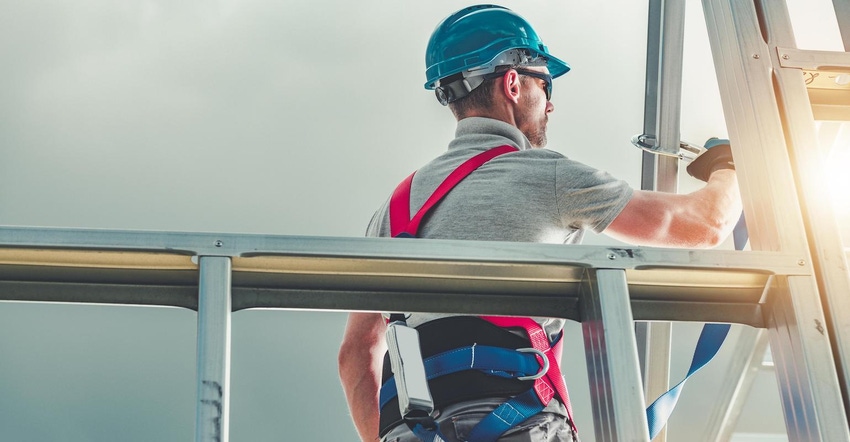Incorporating these strategies into your safety plan before a fall occurs can set everyone on the jobsite up for a safe and successful rescue.

Workers should be trained in available roofing rescue equipment and rescue techniques, along with the hazards of a rescue operation prior to ever getting onto a roof, Rich Trewyn of the National Roofing Contractors Association said in a recent Construction Safety Week webinar. During the recent webinar, held as part of the annual National Safety Stand-Down to Prevent Falls in Construction event hosted by OSHA and the NRCA, Trewyn illustrated several self-rescue techniques and product options for contractors to incorporate into their company’s safety protocols.
“Rescue should be addressed in your company’s written safety program as part of its fall protection plan,” said Trewyn, NRCA’s director of enterprise risk management. “Workers should be trained in available rescue equipment and specific techniques, along with the hazards of a rescue operation prior to ever getting onto a rooftop.”
Trewyn reminded webinar attendees that the first step in any fall scenario is to call 911. However, he noted that many rescue workers are not trained in high-angle rescue, which involves rescuing people from places that can’t be reached by aerial ladders.
With that in mind, Trewyn said that as soon as the rescue squad is on the way, it’s time to implement your company’s rescue plan, which should address the two biggest elements of a fall rescue:
Delaying suspension trauma (also known as orthostatic shock while suspended or harness-induced pathology).
Bringing the fallen worker to a supporting surface.
Trewyn focused exclusively on self-rescue techniques during the webinar but did mention that the second element—getting the victim to a supporting surface—is particularly important when medical care from first responders is necessary.
“A lot of the first responders want to see (the fall victim) on the ground,” said Trewyn. “But even if you can only get them to a supporting surface on the roof, make sure they are accessible to the emergency team that is on its way.”
Understanding suspension trauma
According to the National Library of Medicine’s National Center for Biotechnology Information, suspension trauma is “the natural physiological response to the human body being held motionless in a vertical position for a period of time,” and can result in loss of consciousness and even death.
Suspension trauma can occur when legs are prevented from moving and are lower than the heart—both of which happen when suspended from a harness fall protection system. It can be complicated by other injuries from a fall, such as neck trauma, broken bones, cuts and more.
When a fall happens and the worker is arrested by a harness, Trewyn explained, blood flow is impeded by the leg straps and gravity. Blood collects in large leg muscles and blood flow back to the heart decreases. With the increased heart rate and decreased blood pressure, blood flow to the brain decreases and leads the victim to lose consciousness.
Trewyn listed some basic signs of suspension trauma, including:
Fainting.
Shortness of breath.
Nausea.
Dizziness.
Sweating.
Hot flushes.
Paleness.
Narrowing of field of vision, or loss of vision.
Increased heart rate.
Equipment on the jobsite can be helpful in a rescue situation, including ladders, scaffolds, personnel lifts, pulleys, winches or other descending devices that can help get a fall victim down to the ground or other stable surface so they can be rescued quickly.
However, if there are situations where workers are working solo on the roof or where other workers cannot reach the fall victim, it is important a company’s safety program accounts for such scenarios. (Trewyn did note that it is a better policy not to have workers work alone. “But if you do and that person experiences a fall,” he said, “they need a way to call for help if they cannot perform a self-rescue.)
How to delay suspension trauma with self-rescue strategies
“The safety industry is coming out with new and innovative products all the time,” said Trewyn. “Not to mention the fact that there are a lot of instruments and devices already out on the market”
He focused on self-rescue strategies, noting that all of them are helpful only in situations where the victim remains conscious, but they can help provide more time for emergency teams to arrive on scene.
Use a cell phone or two-way radio.
Provide a self-rescue retractable lanyard.
Teach the boatswain technique.
Trewyn said this mimics the chair used on ships and boats that could take a person safely up to work on masts and sails or clean off the side of the ship. Some safety harnesses feature a finger loop that, when pulled, releases a boatswain chair to alleviate the pressure in the legs created from a fall.
On harnesses that do not include this feature, he said, users can also pull the straps below the buttocks toward the knees to create a chair position. Trewyn played a video in which he demonstrated this technique and noted that this position tends to be a more tolerable one for longer periods of time and takes pressure off the legs and groin area.
However, this technique can be difficult to execute, and Trewyn recommended investing in systems with built-in boatswain chairs.
Utilize suspension trauma straps and slings.
“There are systems that have these built in, or they can be purchased as an after-market product,” said Trewyn. “However, if you don’t practice how to use these prior to a fall, they don’t do much good because it is harder to know how to use in a moment of panic if you’ve never done it before.”
Teach the lifeline loop, Prusik knot and foot wrap techniques using the lifeline rope of the suspension system.
These types of knots and loops help create a way to redirect some of the pressure away from the leg and groin area and to the sole of the foot. Trewyn again played demonstration videos, noting that practicing these techniques ahead of time will make them more useful in rescue situations.
About the Author(s)
You May Also Like




